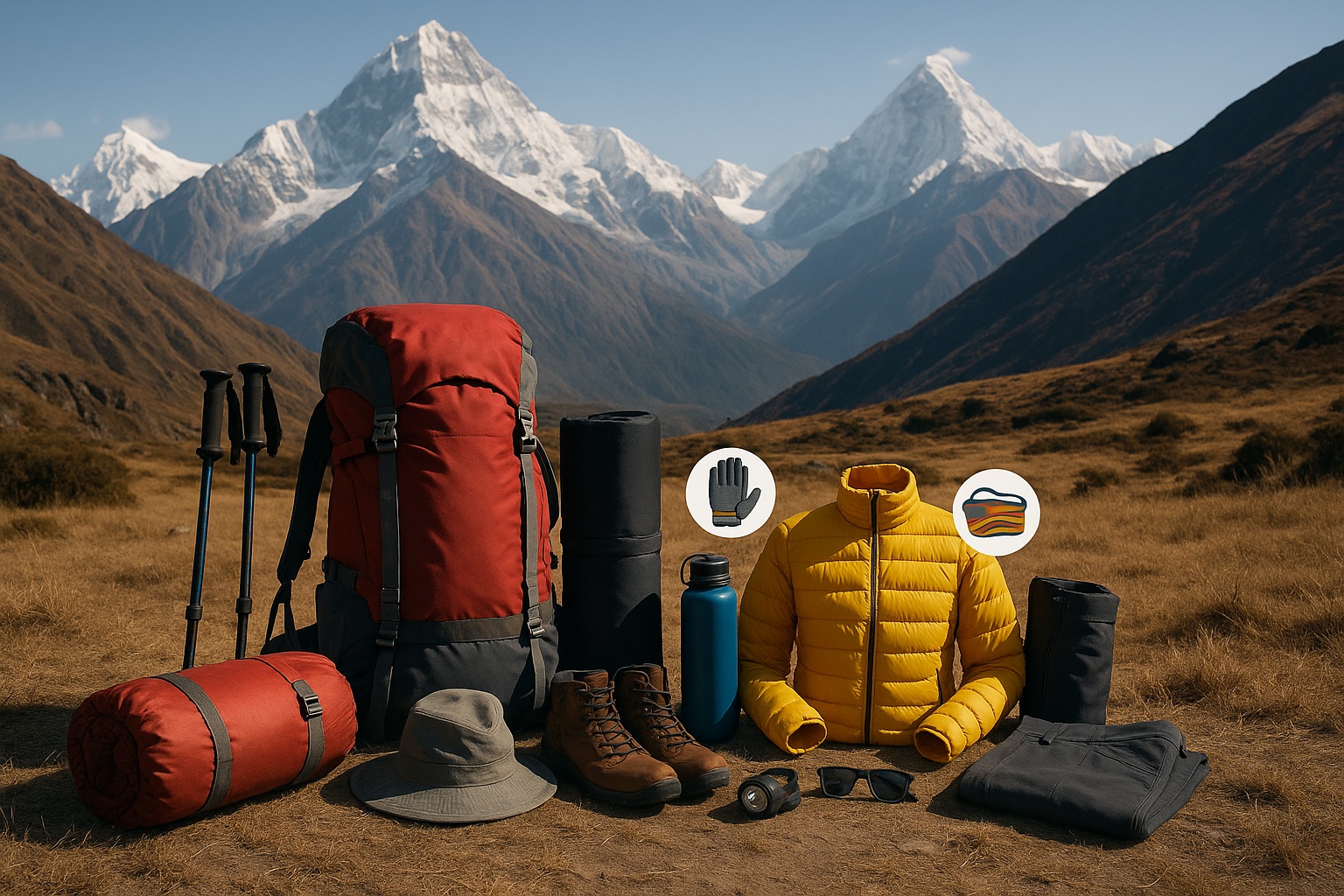




Ultimate Packing List for Trekking in Nepal (With Seasonal Tips)
21/09/2025
Introduction
For those who love trekking, trekking in Nepal is one of
those bucket list adventures people dream about. Imagine yourself walking through
quiet mountain trails, crossing hanging bridges, exploring different cultures
of the Himalayas, and ending the day in a cozy teahouse with views of the Himalayas.
Sounds magical, right?
However, the truth is that if you don’t pack the right gear,
your dream trek can quickly become uncomfortable and ruin your trekking experience.
Packing too much weighs you down, and packing too little leaves you unprepared
for sudden changes in the weather.
That’s why I’ve put together this ultimate packing list for
trekking in Nepal. Over the past 12 years, I’ve guided trekkers from all over
the world, so I know exactly what you’ll need and what you can leave behind. As
the founder of Nepal Boundary Trekking, I want to make sure you’re fully
prepared, so your Himalayan adventure is as safe, comfortable, and
unforgettable as possible, with lots of memories.
Essential Clothing for Trekking in Nepal
Proper layering is the secret and also important for staying
comfortable in the mountains. The weather is unpredictable in the mountains and
can change in minutes. So having the right combination of clothes makes a huge
difference.
1. Base
Layers (Your Second Skin)
Think of base layers as your temperature
regulators. A good set of thermal tops and bottoms keeps you warm and wicks
away sweat. Merino wool or quick-dry synthetics work best.
2. Mid
Layers (Insulation)
This is where you trap heat. A fleece
jacket is perfect for most treks, while a lightweight down jacket keeps you
cozy during chilly evenings at higher altitudes.
3. Outer
Layer (Shield Against the Elements)
Wind and rain can sneak up on you fast. A
waterproof jacket and windproof pants are must-haves. Look for breathable
fabric so you don’t overheat while climbing uphill.
4. Footwear
Your feet carry you through every step of the
journey, so don’t compromise here.
- Trekking
boots: Go for sturdy, broken-in boots with ankle support.
- Socks:
Bring multiple pairs of moisture-wicking socks to prevent blisters.
- Camp
shoes: Lightweight sandals or sneakers to relax in after a long day
of trekking.
Trekking Gear You Shouldn’t Forget
1. Backpack
and Daypack
A 50–65-liter backpack works well for
multi-day treks. If you have porters, you’ll also want a small daypack (20–30
liters) to carry your essentials like water, snacks, and a jacket.
2. Sleeping
Bag
Most teahouses provide blankets, but at
higher altitudes, they may not be enough. A four-season sleeping bag keeps you
warm even in freezing temperatures. You can also rent one in Kathmandu if you
don’t want to carry it from home.
3. Trekking
Poles
These are life-savers on steep descents.
They reduce strain on your knees and give you extra balance on uneven trails.
4. Hydration
Setup
Bring reusable bottles or a hydration
bladder. Pair it with a water purification system—like tablets or a UV
filter—so you can safely refill along the way without buying plastic bottles.
5. Accessories
and Must-Haves
- Sunglasses
& Sunscreen: The UV rays hit hard at higher altitudes.
- Headlamp:
Essential for early morning hikes or power cuts in villages.
- Gloves,
Hat, and Buff: Small items that make a huge difference in warmth.
- Quick-Dry
Towel & Toiletries: Compact, lightweight, and easy to use.
6. Health
and Safety Items
- First-Aid
Kit: Pack basics like blister pads, antiseptics, and bandages.
- Personal
Medication: Always carry enough for your entire trek.
- Altitude
Sickness Prevention: Talk to your doctor about Diamox or
alternatives.
- Travel
Insurance: Don’t skip this. Make sure it covers trekking and
emergency evacuation.
Seasonal Packing Tips for Nepal Treks
Different seasons call for different gear tweaks. Here’s a
quick breakdown:
1. Spring
(March–May)
- Mild
days, cooler nights.
- Pack
light layers and a rain jacket (occasional showers).
- Great
season for flowers and clear mountain views.
2. Summer/Monsoon
(June–August)
- Expect
rain, mud, and leeches.
- Waterproof
boots and rain gear are essential.
- Quick-dry
clothing beats heavy cotton every time.
3. Autumn
(September–November)
- Peak
trekking season with stable weather.
- Layer
up for cold mornings and warm afternoons.
- A
lightweight down jacket is perfect.
4. Winter
(December–February)
- Coldest
season, especially at higher altitudes.
- Heavy
down jacket, extra thermals, and a warmer sleeping bag are
non-negotiable.
- Some
high passes may be closed due to snow.
Packing Tips from Nepal Boundary Trekking
- Pack
light, trek happy: Keep your main pack under 12–15 kg.
- Rent
vs buy: Kathmandu has excellent rental shops for sleeping bags,
jackets, and poles.
- Be
smart, not over-prepared: Carry essentials, but remember teahouses
provide meals and basic bedding.
- Ask
us anytime: Our guides can give tailored gear advice depending on your
trek and season.
Conclusion
Packing smart is the key to enjoying your Himalayan
adventure. With the right gear, you’ll stay comfortable, safe, and ready to
soak in every moment of your trek.
At Nepal Boundary Trekking, we’ve guided trekkers
from around the world. And as a guide, I have guided trekkers for over 12 years
to popular trails and hidden trails. We know what works—and we’re here to make
sure your journey is unforgettable.
Ready to explore Nepal’s breathtaking and hidden trails? Feel
free to contact Nepal Boundary Trekking today, and let's start planning
your trek. Our team is always here to help you throughout your journey.